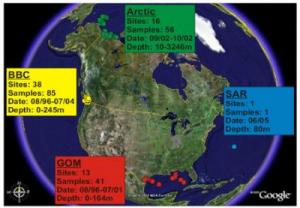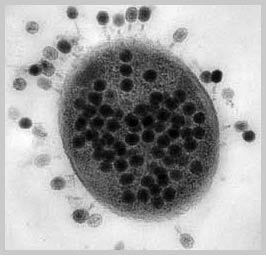Hundreds of thousands of phage species: Available in the world's oceans.

The scientists used the metagenomic method to analyze the virus genes of ocean viruses and have discovered their diversity, distribution and influence on their ecosystems in the world's four ocean regions. we.(Photo: Rohwer et al. / PLoS Biology)
The ocean has many creatures: big, small, and extremely small. Microbial viruses (phage) are microscopic and self-replicating biome communities that can alter the microbial material of microorganisms and ' regulate ' their populations by eating other organisms and live parasites. Although they are very small in size, they are so horrifying, so much so that in just a bucket of water, they are equal to the number of human beings on the planet. And so, they create an extremely ecological effect.
In a new study published online this week in the PloS biology magazine, Mr. Florent Angly, Mr. Forest Rohwer and colleagues presented their research using their metagenomic method in detail about the diversity of bacteriophage in water samples taken from 68 places in 4 ocean areas for 10 years (Sargasso Sea, Gulf of Mexico, British Columbia and Arctic Ocean).
They use pyrosequencing technology (a technique that allows sequencing of DNA sequences at a lower cost than sequencing the traditional way) to larger populations, rather than individual organisms to understand. diversity, geography, classification and activities that affect the ecology of phage.
This method has identified a wide variety of phages with more than 91% of DNA sequences not present in the current database.

Phage (Photo: vet.upenn.edu)
Mr. Angly and colleagues analyzed the distribution of phage in water between water sampling areas and discovered the correlation between geographical distance and genetic differences of phage and control. The hypothesis is that domestic viral genomes change from one region to another.
They also studied that at each location of water sampling, how the virus genomes are identical - in fact, the differences between viral genomes are mostly explained by the relative change in abundance. of phage and therefore support the concept that, although everything is everywhere, the environment will select those things.
Overall, scientists have found that phage samples taken from the coast of British Columbia are the most genetically diverse (suitable for the nutrient-rich habitat of this sea). The remaining 3 phage samples show that diversity increases when the altitude falls below sea level, a trend that has the same results as previous findings from terrestrial ecosystems. In fact, scientists predict that the oceans of the world contain several hundred thousand phage species, distributed over a wide area, including some large areas of organisms that can contain the majority these phage species.
television
- Does phage therapy return to replace antibiotics?
- Hundreds of thousands of marine species are still secret
- Thousands of new creatures appear on the bottom of the Caribbean Sea
- Hundreds of thousands of bullfrogs appeared in Tay Ninh
- Hundreds of thousands of students quit school because of the storm
- Birth time @
- 10 most endangered animals on the planet
- Hundreds of thousands of green jellyfish stranded in Australia
- People are 'killing' the oceans
- The truths always amaze you about the biological world
- Hundreds of new species discovered in coral reefs in Australia (Part I)
- Hundreds of new species discovered in coral reefs in Australia (Part II)
 Surprised: Fish that live in the dark ocean still see colors
Surprised: Fish that live in the dark ocean still see colors Japan suddenly caught the creature that caused the earthquake in the legend
Japan suddenly caught the creature that caused the earthquake in the legend A series of gray whale carcasses washed ashore on California's coast
A series of gray whale carcasses washed ashore on California's coast Compare the size of shark species in the world
Compare the size of shark species in the world